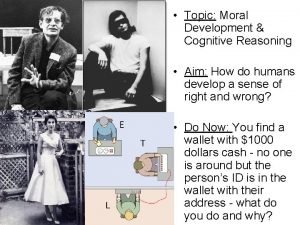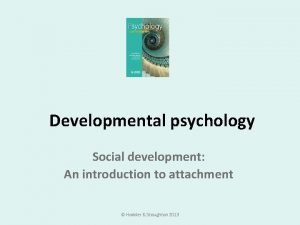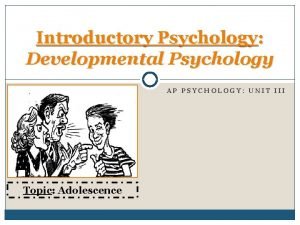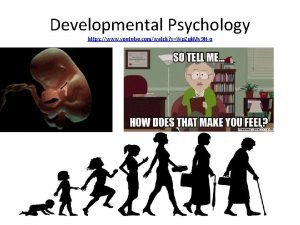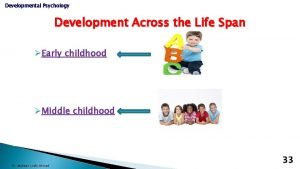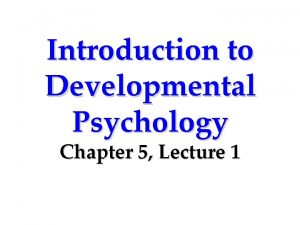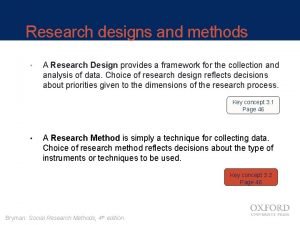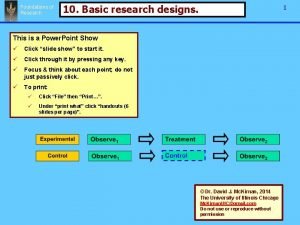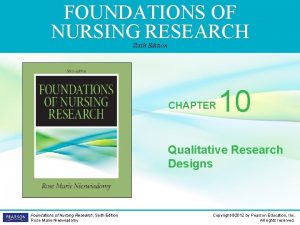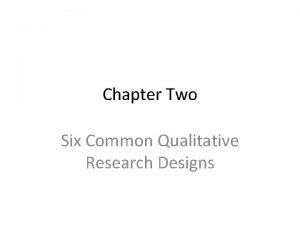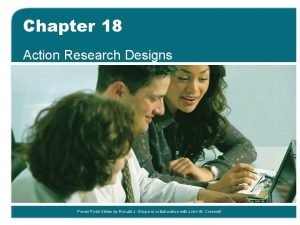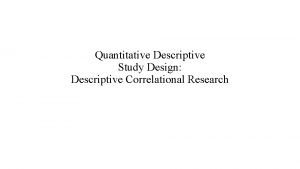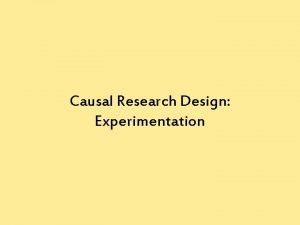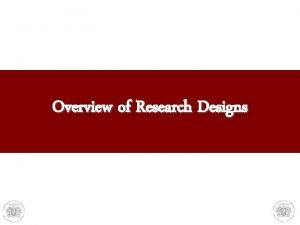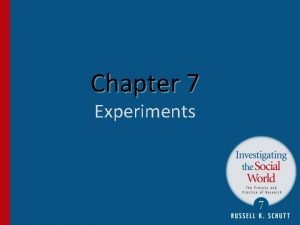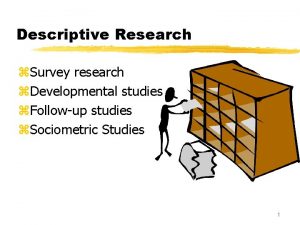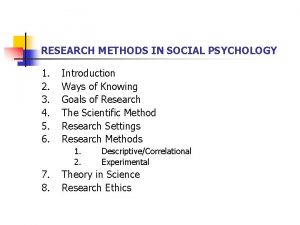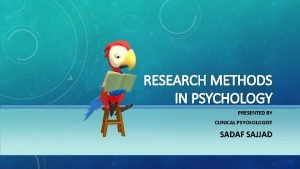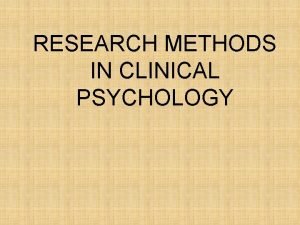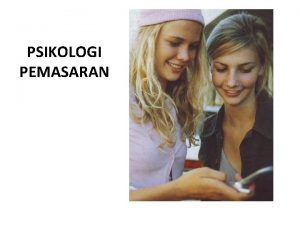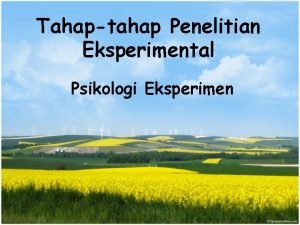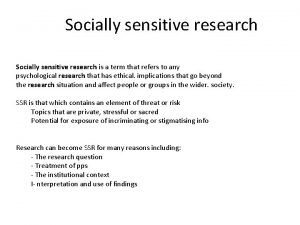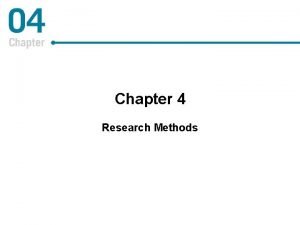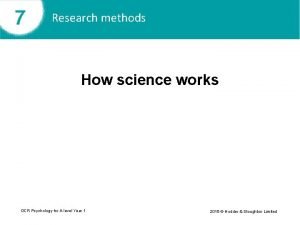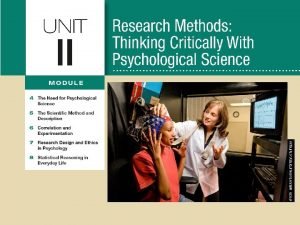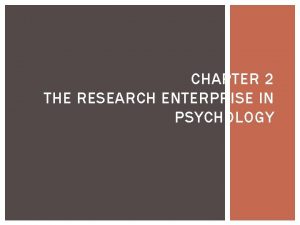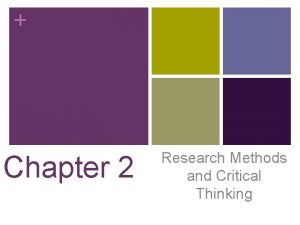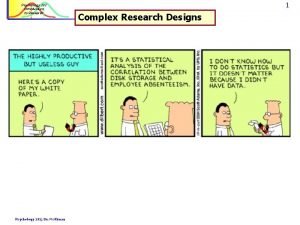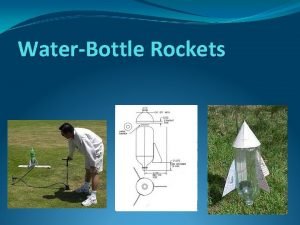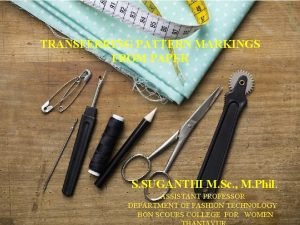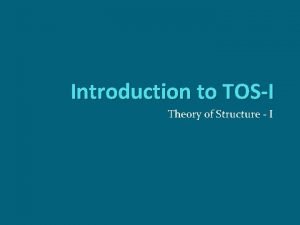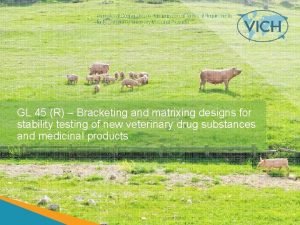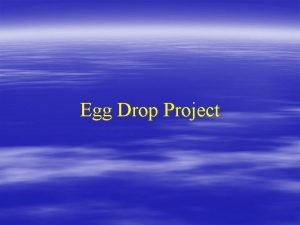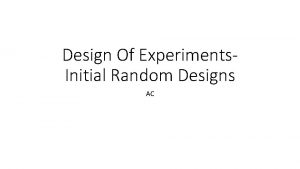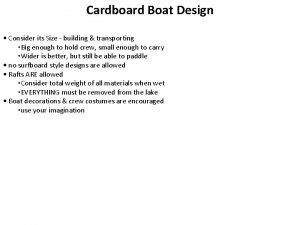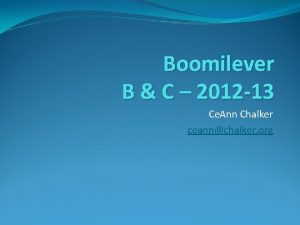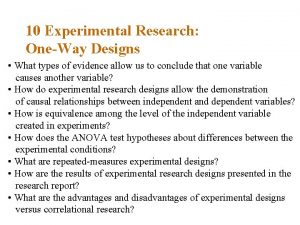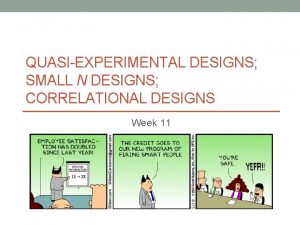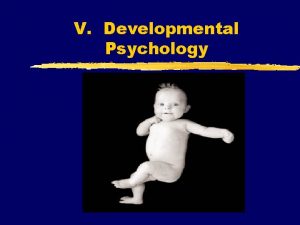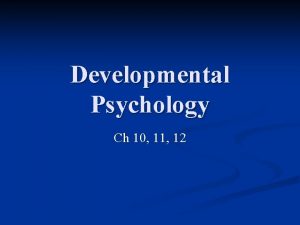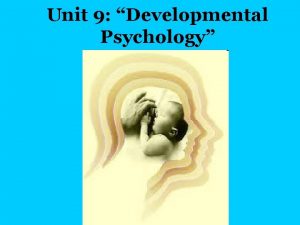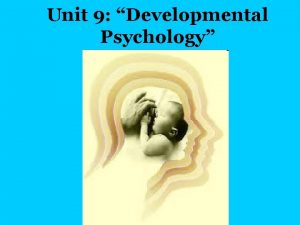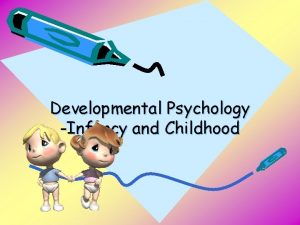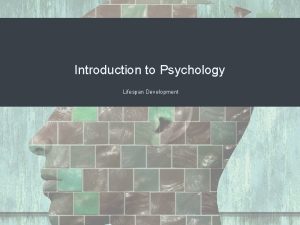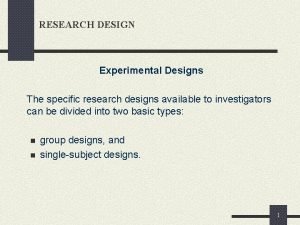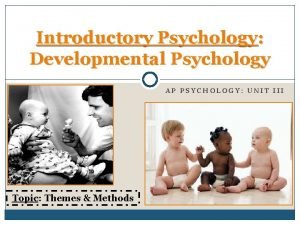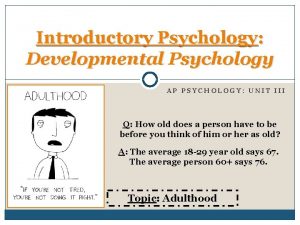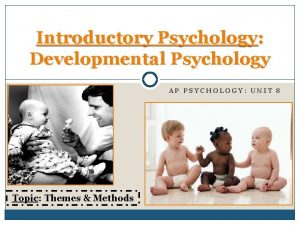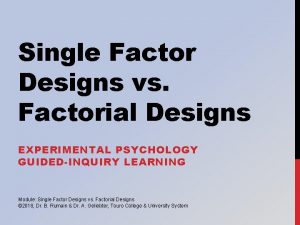DEVELOPMENTAL PSYCHOLOGY 7 9 DEVELOPMENTAL RESEARCH DESIGNS 1


























































































- Slides: 90

DEVELOPMENTAL PSYCHOLOGY 7 -9%

DEVELOPMENTAL RESEARCH DESIGNS (1 OF 5) • Human development: the scientific study of the changes that occur in people as they age from conception until death • The participants who are exposed to the independent variable in any experiment should be randomly assigned to the different experimental conditions • Disadvantage • The age of the people in the study should always be an independent variable, but people cannot be randomly assigned to different age groups

DEVELOPMENTAL RESEARCH DESIGNS (2 OF 5) • Special designs used in researching age-related changes • Longitudinal design • Cross-sectional design • Cross-sequential design

DEVELOPMENTAL RESEARCH DESIGNS (3 OF 5) • Longitudinal design: research design in which one participant or group of participants is studied over a long period of time • Advantage: looks at real age-related changes as those changes occur in the same individuals • Disadvantages: the lengthy amount of time, money, and effort involved in following participants over the years as well as the loss of participants when they move away, lose interest, or die

DEVELOPMENTAL RESEARCH DESIGNS (4 OF 5) • Cross-sectional design: research design in which several different age groups of participants are studied at one particular point in time • Advantages: quick, relatively inexpensive, and easier to accomplish than the longitudinal design • Disadvantage: one is no longer comparing changes in the same individuals as they age; instead, individuals of different ages are being compared to one another • Cohort effect: impact on development when a group of people share a common time period or life experience

DEVELOPMENTAL RESEARCH DESIGNS (5 OF 5) • Cross-sequential design: research design in which participants are first studied by means of a crosssectional design but also followed and assessed for a period of no more than six years

TABLE: A COMPARISON OF THREE DEVELOPMENTAL RESEARCH DESIGNS

AREAS OF DEVELOPMENTAL PSYCHOLOGY Three areas of development: • Physical development: development of the body, is fairly discontinuous, occurring in clearly defined stages that are distinct from each other • Cognitive development: development of thinking and reasoning skills, is fairly continuous, and it changes over time • Psychosocial development: encompasses our emotional and social lives

NATURE VERSUS NURTURE • Nature: the influence of our inherited characteristics on our personality, physical growth, intellectual growth, and social interactions • Nurture: the influence of the environment on personality, physical growth, intellectual growth, and social interactions • Includes parenting styles, physical surroundings, economic factors, and anything that can influence development but does not come from within the person

GENETIC INFLUENCES (1 OF 3) • Study of the human life begins with looking at the complex material contained in the cells of the body that carries the instructions for life itself • DNA molecules: contain the instructions for all of an organism’s traits known as genes

FIGURE: DN A MOLECULE Copyright © 2016, 2012 Pearson Education, Inc. All Rights Reserved

GENETIC INFLUENCES (2 OF 3) • Gene: section of DNA having a certain pattern of chemical elements • Dominant: a gene that actively controls the expression of a trait • Disorders carried by dominant genes: Huntington’s disease and Marfan’s syndrome • Recessive: a gene that tends to fade into the background when paired with a dominant gene; diseases are inherited only when a child receives two recessive genes, one from each parent • Diseases carried by recessive genes: cystic fibrosis, sickle-cell anemia, Tay-Sachs disorder, and phenylketonuria or PKU

GENETIC INFLUENCES (3 OF 3) • Chromosomes: rod-shaped structures found in the nucleus of each cell and are nothing more than tightly wound strands of genes • Each egg and each sperm has 23 chromosomes • A missing or extra chromosome in a cell can cause mild to severe problems in development

ENVIRONMENTAL INFLUENCES • Environmental influences that surround us before birth and during our lives significantly affect our development • Parents or other caretakers: early childhood • Friend or teacher: mid to late teens • Culture

PRENATAL, INFANT AND CHILDHOOD DEVELOPMENT Copyright © 2016, 2012 Pearson Education, Inc. All Rights Reserved

PRENATAL DEVELOPMENT • Ovum: the female sex cell, or egg • Fertilization: the union of the ovum and sperm • Zygote: cell resulting from the union of the ovum and sperm; has 46 chromosomes • Mitosis: the process during which zygote divides first into two cells, then four, then eight, and so on till the mass of the cells becomes a baby • Twins or multiples occur when division process doesn’t happen this way

PRENATAL DEVELOPMENT: TWINNING • Two main types of twins • Monozygotic twins: identical twins • Formed when one zygote splits into two separate masses of cells, each of which develops into a separate embryo • Infants developing from each embryo will be the same sex and have identical features • Dizygotic twins: often called fraternal twins • Occur when two eggs get fertilized by two different sperm, resulting in the development of two zygotes in the uterus at the same time

FIGURE: MONOZYGOTIC AND DIZYGOTIC TWINS Copyright © 2016, 2012 Pearson Education, Inc. All Rights Reserved

STAGES OF PRENATAL DEVELOPMENT • The germinal period: first two weeks after fertilization, during which the zygote moves down to the uterus and begins to implant in the lining • The embryonic period: the period from two to eight weeks after fertilization, during which the major organs and structures of the organism develop • The fetal period: the time from about eight weeks after conception until the birth of the child

THE THREE PERIODS OF PREGNANCY: THE GERMINAL PERIOD • Zygote divides and moves down to the uterus • The mass of cells, now forming a hollow ball, firmly attaches itself to the wall of the uterus • The cells begin to develop into specialized cells – skin cells, heart cells, stem cells and so on Copyright © 2016, 2012 Pearson Education, Inc. All Rights Reserved

THE THREE PERIODS OF PREGNANCY: THE EMBRYONIC PERIOD • Once attached to the uterus, the developing organism is called an embryo • Cells continue to specialize and become the various organs and structures of a human infant • In 2 to 8 weeks from conception, the embryo has primitive eyes, nose, lips, teeth, little arms and legs and a beating heart Copyright © 2016, 2012 Pearson Education, Inc. All Rights Reserved

THE THREE PERIODS OF PREGNANCY: THE FETAL PERIOD • A period of tremendous growth • Length of the fetus increases by about 20 times • Its weight increases from 1 ounce at 2 months to a little over 7 pounds • The organs of the fetus develop and become functional Copyright © 2016, 2012 Pearson Education, Inc. All Rights Reserved

PERIODS OF PREGNANCY: CRITICAL PERIODS • Critical or sensitive periods: times during which certain environmental influences can have an impact on the development of the infant • Prenatal Hazards: • Teratogens: any factor that can cause a birth defect • Alcohol consumption particularly during the critical embryonic period can lead to fetal alcohol syndrome (FAS), a series of physical and mental defects • Exposure to alcohol in early pregnancy is the leading known cause of intellectual disability

PERIODS OF PREGNANCY: TERATOGENS

PHYSICAL DEVELOPMENT • Immediately after birth: • respiratory system begins to function • blood circulates only within the infant’s system as the umbilical cord has been cut • body temperature is regulated by infant’s own activity and body fat

PHYSICAL DEVELOPMENT: REFLEXES • Reflexes: a set of innate involuntary behavior patterns • Used by pediatricians to determine whether or not an infant’s nervous system is working properly • Reflexes that help infants survive • Grasping • Moro (startle) • Rooting • Stepping • Sucking

FIGURE: FIVE INFANT REFLEXES Copyright © 2016, 2012 Pearson Education, Inc. All Rights Reserved

FIGURE (CONTINUED): FIVE INFANT REFLEXES Copyright © 2016, 2012 Pearson Education, Inc. All Rights Reserved

MOTOR DEVELOPMENT • Motor Development: • From birth to about 2 years of age infants show tremendous amount of development in motor skills • Major physical milestones of infancy are: • • • raising head and chest rolling over sitting up with support sitting up without support crawling walking

FIGURE: SIX MOTOR MILESTONES Copyright © 2016, 2012 Pearson Education, Inc. All Rights Reserved

FIGURE (CONTINUED): SIX MOTOR MILESTONES Copyright © 2016, 2012 Pearson Education, Inc. All Rights Reserved

BRAIN DEVELOPMENT • Brain Development • at birth, an infant's brain has over 100 billion neurons • from birth to 3 years, neurons grow as the brain triples in weight due to growth of new dendrites, axon terminals, and increasing numbers of synaptic connections • natural process • Synaptic pruning: necessary loss of neurons as unused synaptic connections and nerve cells are cleared away to make way for functioning connections and cells

SENSORY DEVELOPMENT (1 OF 2) • Sensory Development at Birth • Most sensory abilities such as the sense of touch, smell, and taste are fairy well developed • Hearing is functional at birth and takes a little while to reach its full potential • Newborns seem most responsive to high pitches, as in a woman’s voice, and low pitches, as in a male’s voice • Vision is least functional and takes six months to fully develop; newborns have poor color perception and a fixed distance of about 7 -10 inches for clear vision

SENSORY DEVELOPMENT (2 OF 2) • Methods to help gauge infant's sensory abilities: • Preferential looking: assumes that the longer an infant spends looking at a stimulus, the more the infant prefers that stimulus over others • Habituation: the tendency for infants (and adults) to stop paying attention to a stimulus that does not change

COGNITIVE DEVELOPMENT • Brain triples its weight in the first two years; by 5, the brain is 90 percent of its adult weight, paving the way for major advances in cognitive development such as: • Development of thinking • Problem solving • Memory

COGNITIVE DEVELOPMENT: PIAGET'S THEORY • Jean Piaget: developed a four-stage theory of cognitive development based on observation of infants and children • According to Piaget’s theory, children: • form schema, a mental concept formed through experiences with objects and events • possess schemata (plural of schema) by virtue of a process called assimilation • alter the schema to include further detail in a process called accommodation

PIAGET’S THEORY: SENSORIMOTOR STAGE (1 OF 2) • https: //www. youtube. com/watch? v=Jt 3 -PIC 2 n. Cs • Sensorimotor stage (birth to age 2): the stage in which the infant uses his or her senses and motor abilities to interact with objects in the environment • Infants: • have involuntary reflexes at birth • begin to interact deliberately with objects by grasping, pushing, tasting as their sensory and motor development progresses • move from repetitive actions to complex patterns

PIAGET’S THEORY: SENSORIMOTOR STAGE (2 OF 2) • By end of sensorimotor stage, infants: • develop a sense of object permanence, the knowledge that an object exists even when it is not in sight • develop symbolic thought, the ability to represent objects in one’s thoughts with symbols such as words • are capable of thinking in simple symbols and planning out actions

PIAGET’S THEORY: PREOPERATIONAL STAGE (1 OF 2) • Preoperational stage (ages 2 -7): the stage of cognitive development in which the preschool child learns to use language as a means of exploring the world • At this stage, a child: • develops language and concepts • can ask questions and understand through symbolic thinking • is not yet capable of logical thinking • believes anything that moves is alive (animism)

PIAGET’S THEORY: PREOPERATIONAL STAGE (2 OF 2) • Limitations of children in this stage • They tend to believe that what they see is literally true • Egocentrism: the inability to see the world through anyone else’s eyes • Centration: the tendency of a young child to focus only on one feature of an object while ignoring other relevant features; due to centration, children in this stage often fail to understand that altering the way something looks doesn’t change its substance • Conservation: the ability to understand that altering the appearance of something does not change its amount

FIGURE: CONSERVATION EXPERIMENT Conservation is the ability to understand that altering the appearance of something does not change its amount, its volume, or its mass. Copyright © 2016, 2012 Pearson Education, Inc. All Rights Reserved

PIAGET’S THEORY: CONCRETE OPERATIONS STAGE (1 OF 2) • Concrete operations stage (ages 7 -12): the stage of cognitive development in which the school-age child becomes capable of logical thought processes but is not yet capable of abstract thinking

PIAGET’S THEORY: CONCRETE OPERATIONS STAGE (2 OF 2) • In concrete operations stage, children are: • Capable of conservation and reversible thinking • Capable of considering all the relevant features of any given object • Begin to think more logically • Ask questions and arrive at their own rational conclusions • Major limitation of children in this stage: • Inability to deal effectively with abstract concepts • Concepts that do not have some physical, concrete, touchable reality

PIAGET’S THEORY: FORMAL OPERATIONS STAGE • Formal operations stage (age 12 to adulthood): the stage in which the adolescent becomes capable of abstract thinking • In this stage, children • understand concepts that have no physical reality • are deeply involved in hypothetical thinking

CRITICISM OF PIAGET’S THEORY • Piaget’s theory has been criticized on the following accounts: • the idea of distinct stages of cognitive development is not completely correct • changes in thought are continuous and gradual rather than reached by jumping from one stage to another • Pre-schoolers are not egocentric • object permanence exists much earlier than Piaget thought

TABLE: PIAGET’S FOUR-STAGE THEORY Copyright © 2016, 2012 Pearson Education, Inc. All Rights Reserved

VYGOTSKY’S THEORY (1 OF 2) • https: //www. youtube. com/watch? v=-p_-0 n 2 f 35 o • Lev Vygotsky stressed: • social and cultural interactions with other people, typically more highly skilled children and adults, are important for cognitive development • children develop cognitively when someone else helps them by asking leading questions and providing examples of concepts in a process called scaffolding • Scaffolding: the process by which a more skilled learner gives help to a less skilled learner, reducing help as the less skilled learner improves

VYGOTSKY’S THEORY (2 OF 2) • According to Vygotsky, each developing child has a zone of proximal development (ZPD) • Zone of proximal development (ZPD): the difference between what a child can do alone and what that child can do with the help of a teacher

LANGUAGE DEVELOPMENT • Language development allows children to: • Think in words rather than images • Ask questions • Communicate their needs • Form concepts • Child-directed speech: • A child’s style of speaking is influenced by the way adults and older children talk to infants and very young children, with higher pitched, repetitious, sing-song speech patterns

STAGES OF LANGUAGE DEVELOPMENT (1 OF 3) • Cooing • Babbling • One-Word Speech (Holophrases) • Telegraphic Speech • Whole Sentences

STAGES OF LANGUAGE DEVELOPMENT (2 OF 3) • Cooing: vowel-like sounds made by babies at around two months of age • Babbling: consonant sounds (in addition to vowel sounds) made by infants at about 6 months of age • One-word speech: actual words, typically nouns representing an entire phrase of meaning in one word (also known as holophrases) spoken by babies just before or around age 1

STAGES OF LANGUAGE DEVELOPMENT (3 OF 3) • Telegraphic speech: at around a year and a half, toddlers begin to string words together to form short, simple sentences using nouns, verbs, and adjectives • Whole sentences: by age 6 or so children learn to use grammatical terms and increase the number of words in their sentences

TEMPERAMENT (1 OF 3) • Psychological and social development of infants and children involves: • development of personality • development of relationships • a sense of being male or female • Ways in which infants demonstrate personalities are: • temperament • attachment

TEMPERAMENT (2 OF 3) • Temperament: behavioral and emotional characteristics that are fairly well established at birth such as: • Easy: regular in their schedules of waking, sleeping, and eating , adaptable to change, happy babies, easily soothed when distressed • Difficult: opposite of easy ones; irregular in their schedules, unhappy about any kind of change, are loud, active, and tend to be crabby • Slow to warm up: less grumpy, quieter but slow to adapt to change; if change is introduced gradually, they warm up to new people and new situations

TEMPERAMENT (3 OF 3) • Temperament styles are strongly influenced by heredity or somewhat by the environment in which the infant is raised • A “difficult” infant raised by parents who are loud and active exemplifies very close “goodness of fit” of the infant’s temperament to the parents’ temperament • A poor fit can make it difficult to form an attachment

ATTACHMENT (1 OF 2) • Attachment: • is the emotional bond that forms between an infant and a primary caregiver • is formed within the first 6 months of the infant’s life • shows in a number of ways during the second 6 months, such as stranger anxiety and separation anxiety • Stranger anxiety: wariness of strangers • Separation anxiety: fear of being separated from the caregiver

ATTACHMENT (2 OF 2) • Mary Ainsworth conducted an experiment by exposing infants to strange situations and identified four attachment styles: • Secure • Avoidant • Ambivalent • Disorganized-disoriented

ATTACHMENT STYLES • Secure: explore happily; upset when mother departs, but easily soothed upon her return • Avoidant: willing to explore, don’t “touch base, ” react very little to mother’s absence or return • Ambivalent: clinging, unwilling to explore; upset when mother leaves, angry with her on her return • Disorganized-disoriented: unable to decide reaction to mother’s return, approach mother with their eyes turned away from her, avoid eye contact

CULTURAL INFLUENCE ON ATTACHMENT • Mothers in the United States tend to wait for a child to express a need before trying to fulfill that need • Japanese mothers prefer to anticipate the child’s needs • Attachment is an important first step in forming relationships with others

HARLOW’S MONKEY EXPERIMENT • Harry Harlow’s Monkey Experiment • In this experiment, the wire surrogate “mother” provides the food for this infant rhesus monkey. But the infant spends all its time with the soft, cloth-covered surrogate. According to Harlow, this demonstrates that “contact comfort was an important basic affectional or love variable. ” • Harlow’s work represents one of the earliest investigations into the importance of touch in the attachment process • https: //www. youtube. com/watch? v=Or. NBEhzjg 8 I

ERIKSON’S THEORY • Erikson’s theory: focused on the relationship of the infant and the child to significant others in the immediate surroundings – parents and then later teachers and even peers • Erikson believed: • Development occurred in a series of eight stages, the first four of which occur in infancy and childhood • Each stage is an emotional crisis, or a turning point • The crisis in each stage must be successfully met for normal, healthy psychological development • https: //www. youtube. com/watch? v=z 1 c 1 y-mm_io

ERIKSON’S PSYCHOSOCIAL STAGES OF DEVELOPMENT (1 OF 3)

ERIKSON’S PSYCHOSOCIAL STAGES OF DEVELOPMENT (2 OF 3)

ERIKSON’S PSYCHOSOCIAL STAGES OF DEVELOPMENT (3 OF 3)

ADOLESCENCE AND ADULTHOOD Copyright © 2016, 2012 Pearson Education, Inc. All Rights Reserved

PHYSICAL DEVELOPMENT (1 OF 3) • Adolescence: the period of life from about age 13 to the early 20 s, during which a young person is no longer physically a child but is not yet an independent, self-supporting adult • The “teens, ” from ages 13 to 19 • Concerns how a person deals with life issues such as work, family, and relationships • Clear age of onset • End may come earlier or later for different individuals

PHYSICAL DEVELOPMENT (2 OF 3) • Sign of the beginning of adolescence is the onset of puberty • Physical changes: Primary sex characteristics (growth and maturation of the actual sex organs) and secondary sex characteristics (changes in the body such as the development of breasts and body hair) • Result of a complex series of glandular activities, stimulated by the “master gland” or the pituitary gland • Psychosocial and environmental factors (stress, exercise, and nutrition) may impact timing of puberty • Takes place at around age 10 for girls and around age 12 for boys

PHYSICAL DEVELOPMENT (3 OF 3) • Development of the brain continues well into the early 20 s, though changes of puberty are relatively complete after 4 years • Prefrontal cortex of the brain is responsible in part for impulse control, judgment and decision making, and the organization and understanding of information • Does not complete its development until about age 25 years and may lead to risky behavior in adolescents

COGNITIVE DEVELOPMENT (1 OF 2) • Cognitive development: less visible than the physical development • Change in the way adolescents think about themselves, their peers and relationships, and the world around them • Piaget’s final stage of formal operations: abstract thinking • Search for an “ideal” world

COGNITIVE DEVELOPMENT (2 OF 2) • Egocentrism and introspection: emerge as the personal fable and the imaginary audience • Personal fable: common feeling is “You just don’t understand me; I’m different from you” • “It can’t happen to me” is a risky but common thought • Imaginary audience: extreme self-consciousness

MORAL DEVELOPMENT (1 OF 2) • Understanding of “right” and “wrong” • Lawrence Kohlberg outlined a theory of the development of moral thinking through looking at how people of various ages responded to stories about people caught up in moral dilemmas • Proposed three levels of moral development, or the knowledge of right and wrong behavior • Carol Gilligan (1982): men and women have different perspectives on morality

TABLE: KOHLBERG’S THREE LEVELS OF MORALITY

MORAL DEVELOPMENT (2 OF 2) • Gilligan’s criticisms of Kohlberg’s theory: • Male-oriented • Proposed her theory of stages of female moral development based on her idea of moral voices. According to Gilligan, there are two kinds of moral voices: that of the masculine and the feminine. The masculine voice is "logical and individualistic", meaning that the emphasis in moral decisions is protecting the rights of people and making sure justice is upheld. The feminine voice places more emphasis on protecting interpersonal relationships and taking care of other people

PARENT/TEEN CONFLICT • Certain amount of “rebellion” and conflict is a necessary step • Most parent/teen conflict is over trivial issues –hair, clothing, taste in music, and so on • Big moral issues – they are in agreement (Giancola, 2006)

PARENTING STYLES (1 OF 2) • Relationships between parents and children can be challenging during adolescence • Parenting styles • Authoritarian parenting: parent is stern, rigid, demanding perfection, controlling, uncompromising, and has a tendency to use physical punishment • Permissive parenting: parents put very few demands on their children for behavior

PARENTING STYLES (2 OF 2) • Permissive neglectful: parents simply aren’t involved with their children, ignoring them and allowing them to do whatever they want until it interferes with what the parent wants • Permissive indulgent: parents seem to be too involved with their children, allowing them to behave in any way they wish • https: //www. youtube. com/watch? v=Pzy. XGUCngo. U

ERIKSON’S IDENTITY VERSUS ROLE CONFUSION • Identity versus role confusion • Values in life and beliefs concerning things such as political issues, career options, and marriage • Successful teens of the earlier four stages are much better “equipped” to resist peer pressure • Not successful teens come into adolescence with a lack of trust in others, feelings of guilt and shame, low selfesteem, and dependency on others

PHYSICAL CHANGES DURING ADULTHOOD • Cellular clock theory (Hayflick, 1977): biologically based • Cells are limited in the number of times they can reproduce to repair damage • Evidence: existence of telomeres, structures on the ends of chromosomes that shorten each time a cell reproduces (Martin & Buckwalter, 2001) • Stress speeds the destruction of telomeres

PHYSICAL DEVELOPMENT (1 OF 3) • Adulthood • Young adulthood • Middle age • Late adulthood • Emerging adulthood: a time from late adolescence through the 20 s, refers mainly to those in developed countries who are childless, do not live in their own home, and are not earning enough money to be independent

PHYSICAL DEVELOPMENT (2 OF 3) • 20 s – time of peak physical health, sharp senses, fewer insecurities, and mature cognitive abilities • 40 s – vision and hearing are beginning to decline, and bifocal lenses may become necessary as the lens of the eye hardens • Skin begins to show more wrinkles • Hair turns gray (or falls out) • Height begins to decrease • In women, estrogen declines as the body’s reproductive system prepares to cease that function

PHYSICAL DEVELOPMENT (3 OF 3) • 50 s – most women go through menopause • 60 s or 70 s – hearing loss becomes noticeable

EFFECTS OF AGING ON HEALTH • Many health problems first occur, although their true cause may have begun in the young adulthood years • Common health problems that may show up in middle age are high blood pressure, skin cancer, heart problems, arthritis, and obesity • Common causes of death in middle age are heart disease, cancer, and stroke

HOW TO KEEP YOUR BRAIN YOUNG • “Use it or lose it” • Avoid memory problems and senile dementias by exercising mental abilities • Maintain a healthy level of cognitive functioning • Work challenging crossword puzzles • Positively impact the brain • Reading, having an active social life, going to plays, taking classes, staying physically active

ERIKSON’S INTIMACY VERSUS ISOLATION: FORMING RELATIONSHIPS • True intimacy: ability to trust, share, and care, while still maintaining one’s sense of self

ERIKSON’S GENERATIVITY VERSUS STAGNATION: PARENTING THE NEXT GENERATION • Middle adulthood: persons who have found intimacy can now focus outward on others • Generativity: parenting the next generation and helping them through their crises • Educators, supervisors, health care professionals, doctors, and community volunteers might be examples of positions that allow a person to be generative

ERIKSON’S EGO INTEGRITY VERSUS DESPAIR: DEALING WITH MORTALITY • Life becomes more urgent as the realities of physical aging and the approaching end of life become harder and harder to ignore • Life review: people look back on the life they have lived and deal with mistakes, regrets, and unfinished business • Integrity: feeling of wholeness when people can look back and feel that their lives were relatively full and come to terms with regrets and losses; the final completion of the identity, or ego • Despair: feeling of despair – a sense of deep regret over things that will never be accomplished because time has run out; experienced if people have many regrets and lots of unfinished business

DEATH AND DYING (1 OF 2) • Elisabeth Kübler-Ross – theorized five stages of reaction when faced with death • Denial: refusal to believe that the diagnosis of death is real • Anger: at death itself and the feelings of helplessness to change things • Bargaining: dying person tries to make a deal with doctors or even with God • Depression: sadness from losses already experienced and yet to come • Acceptance: of the inevitable; dying person quietly awaits death • https: //www. youtube. com/watch? v=G_Z 3 lmidmr. Y

DEATH AND DYING (2 OF 2) • Criticism of Elisabeth Kübler-Ross’s theory • Some people do not have time to go through all of these stages or go through them in the listed order • Some theorists do not agree with the stage idea, seeing the process of dying as a series of ups and downs, with hope on the rise at times and then falling, to be replaced by a rise in despair or disbelief • No “right” way to face death: each person’s dying process is unique • Kübler-Ross’s theory is also strongly tied to Western cultural values and norms

APPLYING PSYCHOLOGY TO EVERYDAY LIFE • Cross-Cultural Views on Death • Westerners see a person as either dead or alive • In many Native American cultures a person who by Western standards is clearly alive is mourned as already dead • In Hinduism, it is believed that the dead person’s soul will be reincarnated at either a higher level or a lower level of status, depending upon how the person lived his or her life • In the culture of the Northern Cheyenne Native American tribe, death is considered only the end of the physical body, while the self and one’s Cheyenne nature will persist

KEY TERMS CHECKLIST • Human development • Scaffolding • Longitudinal design • Stages of language development • Cross-sectional design • Temperament • Cross-sequential design • Attachment • Nature vs. Nurture • Mary Ainsworth & theory • Dominant gene • Harry Harlow • Recessive gene • Erikson & theory • Teratogens • Adolescence • Jean Piaget & theory • Lawrence Kohlberg & theory • Lev Vygotsky & theory • Carol Gilligan & theory • Elisabeth Kubler-Ross & theory
 Research methods in developmental psychology
Research methods in developmental psychology Initiative vs guilt
Initiative vs guilt Lawrence kohlberg developmental psychology
Lawrence kohlberg developmental psychology Gestalt
Gestalt What was john bowlby attachment theory
What was john bowlby attachment theory Adolescent age range psychology
Adolescent age range psychology Devonte is a graduate student in developmental psychology
Devonte is a graduate student in developmental psychology Unit 3 developmental psychology
Unit 3 developmental psychology Ucf psychology classes
Ucf psychology classes Sublimimation
Sublimimation Psychology
Psychology Chapter 5 developmental psychology
Chapter 5 developmental psychology Qualitative paper example
Qualitative paper example Research design
Research design Basic research designs
Basic research designs Qualitative research designs chapter 10
Qualitative research designs chapter 10 Types of qualitative design in research
Types of qualitative design in research Types of action research design
Types of action research design Types of empirical research
Types of empirical research Quasi experiment advantages and disadvantages
Quasi experiment advantages and disadvantages Correlational descriptive research design
Correlational descriptive research design Analyzing and interpreting data in research
Analyzing and interpreting data in research Exploratory vs descriptive vs causal research
Exploratory vs descriptive vs causal research Causal research example
Causal research example Example of conclusive research design
Example of conclusive research design Solomon four group design
Solomon four group design What are the characteristics of qualitative research?
What are the characteristics of qualitative research? Types of research design exploratory
Types of research design exploratory Classification of research design
Classification of research design Conclusive research
Conclusive research Quasi-experimental research designs
Quasi-experimental research designs Quasi-experimental research designs
Quasi-experimental research designs Developmental research design
Developmental research design Sociometric test questionnaire
Sociometric test questionnaire Positive psychology ap psychology definition
Positive psychology ap psychology definition Psychology chapter 13
Psychology chapter 13 Fundamental attribution error ap psychology
Fundamental attribution error ap psychology Pure psychology
Pure psychology Social psychology is the scientific study of:
Social psychology is the scientific study of: Health psychology definition ap psychology
Health psychology definition ap psychology Correlational research psychology
Correlational research psychology Method of social psychology
Method of social psychology Correlational research psychology
Correlational research psychology Research design in clinical psychology
Research design in clinical psychology Pertanyaan tentang psikologi konsumen
Pertanyaan tentang psikologi konsumen Sential
Sential Experimental psychology research topics
Experimental psychology research topics Socially sensitive research definition
Socially sensitive research definition Research methods in abnormal psychology
Research methods in abnormal psychology Ocr psychology research methods
Ocr psychology research methods Module 7 research design and ethics in psychology
Module 7 research design and ethics in psychology Subfields of psychology
Subfields of psychology Goals of scientific enterprise in psychology
Goals of scientific enterprise in psychology Critical thinking chapter 2 answers
Critical thinking chapter 2 answers Factorial research design in psychology
Factorial research design in psychology Research enterprise in psychology
Research enterprise in psychology Aerodynamics of a water bottle rocket
Aerodynamics of a water bottle rocket Thank you page
Thank you page Ancient egypt floral design
Ancient egypt floral design Rubber band racer designs
Rubber band racer designs Turf areas in xeriscaping designs should be seeded in
Turf areas in xeriscaping designs should be seeded in Principles of experimental design
Principles of experimental design Premier designs hostess benefits
Premier designs hostess benefits Scilympiad soni
Scilympiad soni Characteristics of output
Characteristics of output Abstraction-occurrence design pattern
Abstraction-occurrence design pattern Medieval shield designs
Medieval shield designs Caylua designs
Caylua designs Triangular arch
Triangular arch Premier designs hostess order form
Premier designs hostess order form Hopewell designs
Hopewell designs Ancient egyptian floral design
Ancient egyptian floral design Bracketing and matrixing designs for stability testing
Bracketing and matrixing designs for stability testing Factorial design
Factorial design Randomized block design
Randomized block design Egg fall project
Egg fall project Channel design decisions with examples
Channel design decisions with examples Random designs
Random designs Computer arithmetic: algorithms and hardware designs
Computer arithmetic: algorithms and hardware designs Teardrop co2 car
Teardrop co2 car Fast dragster designs
Fast dragster designs Designs inside a nail enhancement
Designs inside a nail enhancement Cardboard boat design
Cardboard boat design Simple cardboard boat designs
Simple cardboard boat designs Winning boomilever designs
Winning boomilever designs Speak about variables affecting channel structure?
Speak about variables affecting channel structure? One way experimental design
One way experimental design Voxtron designs
Voxtron designs Egg drop designs
Egg drop designs Misunderstood tattoos
Misunderstood tattoos Geometric surfboard designs
Geometric surfboard designs


